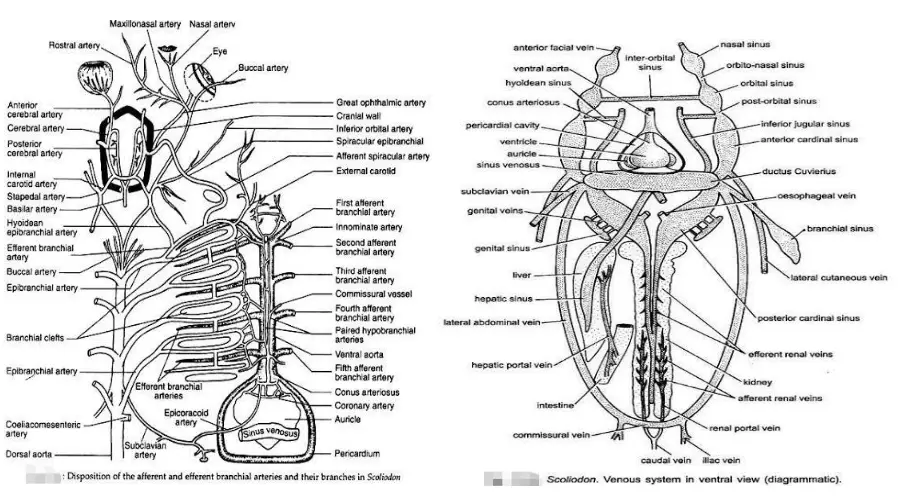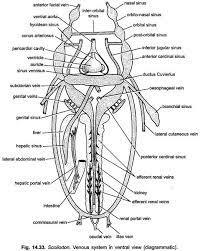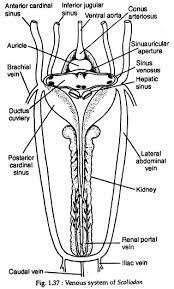In the venous system in Scoliodon deoxygenated blood from different parts of the body is collected through the venous system to the heart, the vein wall is thicker than the wall of the artery. In vein, the blood pressure is not high as in the case of the artery, in the lumen of vein valves present at a certain interval which prevents the backflow of blood.
One very important feature in the venous system of Scoliodon is the presence of a large number of large-sized spaces or sinuses in their venous system. Now we will discuss the venous system in Scoliodon in different segments for proper understanding
Table of Contents
Anterior Cardinal System:
The deoxygenated blood from the head is collected by two sinuses, on each lateral side, they present and collect the deoxygenated blood from the head – inferior jugular sinus and internal jugular sinus.
Inferior Jugular Sinus:
It is a small median sinus present ventrally which collects blood from the gill pouches, the floor of the buccopharyngeal cavity, and pericardial region, finally, the interior jugular sinus opens into the ductus Cuvierius.

Internal Jugular Sinus:
It collects the blood from the dorsal region of the head and gill pouches present dorsolaterally and it is larger than the inferior jugular sinus. On the anterior side, it has an anterior facial vein that collects blood from the rostrum region, then the facial vein joins with the nasal sinus. The nasal sinus or olfactory sinus is present behind the olfactory sac, the olfactory sinus then connects to the orbital sinus through a narrow neck of orbito-nasal sinus.
On the floor of the skull, an interorbital sinus is present which connects the orbital sinus of both sides, orbital sinus connects to the anterior cardinal sinus through a narrow postorbital sinus. The anterior cardinal sinus of both sides then joins with the ductus Cuvierius.
Near the first pair of gill hyoidean sinus present which connects the inferior jugular vein with the anterior cardinal sinus.
Posterior Cardinal System or Renal Portal System:
The renal portal system is an important feature of Chondricthys because first time in Chondricthys we can see the renal portal system. The caudal vein collects the deoxygenated blood from the tail region and runs parallelly along the caudal artery in the haemal canal of the tail vertebrae. When the caudal vein reaches to cloaca region it bifurcates into two branches – the right renal portal vein and the left renal portal vein.
The right renal portal vein on the dorsal side of the right kidney branch into several afferent renal portal veins and the left renal portal vein gives a branch to the left kidney. The afferent renal vein of each side breaks into a fine network of capillaries, the small parietal vein also comes from the body wall and joins with the renal portal vein.

The capillaries of the afferent renal veins in both kidneys join together on each side to form an efferent renal vein, all the efferent renal veins again join into a large median blood vessel. The common vessel on the anterior side bifurcates into two posterior cardinal sinuses.
Posterior Cardinal sinuses are much wider in front of kidneys and they receive oesophageal vein from each side. Several genital veins come from the genital sinuses of both sides and open into the posterior cardinal sinuses of each side.
The two posterior cardinal sinuses finally open into the large space of ductus Cuvierius and the ductus Cuvierius finally open into the sinus venosus.
Hepatic Portal System:
The hepatic portal system is not the first time in Scoliodon because the hepatic portal system is also present in other groups of animals much earlier than Chondricthys. The hepatic portal system is a network of veins that comes from different parts of the alimentary canal and their associated glands which all join into a large hepatic portal vein.
The hepatic portal vein gives a branch to each lobe of the liver and breaks down into a fine network of capillaries that join together and open sinus venosus.
Lateral Abdominal System:
The large abdominal lateral vein collects blood from the internal lateral wall of the body wall, cloacal region, from the paired fins, the lateral abdominal vein on each side on the posterior region joined together by a commissural vein.
The commissural vein joins with the iliac vein on each side, the iliac vein collects blood from the pelvic fins. Two subclavian veins from each side open into the ductus Cuvierius laterally.

Cutaneous System:
The cutaneous system has a dorsal vein, a ventral vein, and two lateral veins which collect blood from the skin and open into the ductus Cuvierius which finally opens into the sinus venosus.
Detailed Study On
Respiratory System of Scoliodon
Digestive Glands and Feeding Mechanism in Scoliodon
Coelom and Viscera in Scoliodon
Placoid Scales In Scoliodon (Exoskeleton)
Skin of Scoliodon (Integument)
Hi Everyone!!! Welcome to Imaluop. Imaluop always try to learn some new and he want to share to other people. Here we will try to learn various topics on Science, specially on Biological Sciences.